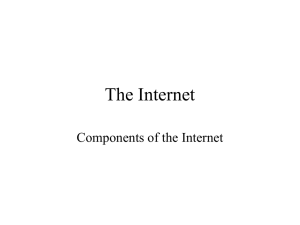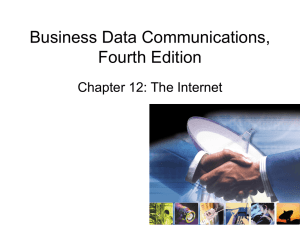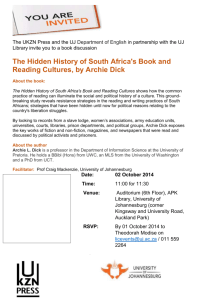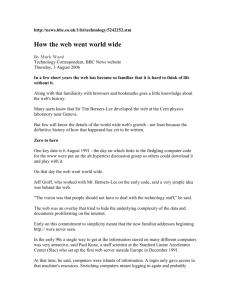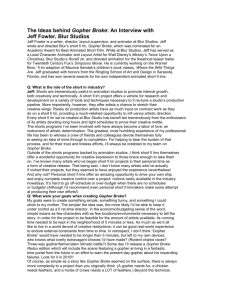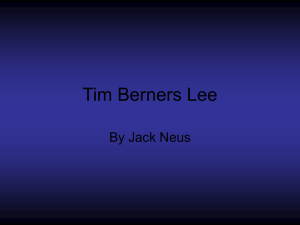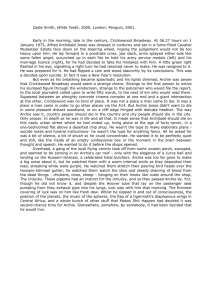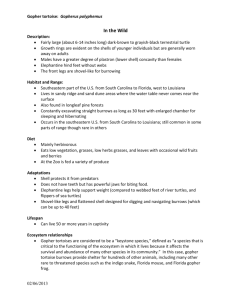Tim Berners -Lee - Computer Society Of India
advertisement
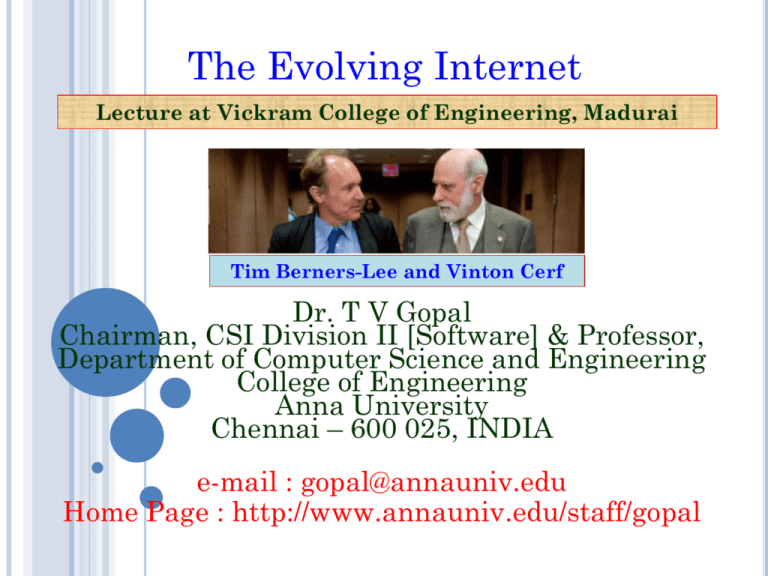
The Evolving Internet Lecture at Vickram College of Engineering, Madurai Tim Berners-Lee and Vinton Cerf Dr. T V Gopal Chairman, CSI Division II [Software] & Professor, Department of Computer Science and Engineering College of Engineering Anna University Chennai – 600 025, INDIA e-mail : gopal@annauniv.edu Home Page : http://www.annauniv.edu/staff/gopal THE VISIONARIES Visionary thinking by people in the early 1960s J.C.R. Licklider of MIT first proposed a global network of computers in 1962, and moved over to the Defense Advanced Research Projects Agency (DARPA) in late 1962 to head the work to develop it. Leonard Kleinrock of MIT and later UCLA developed the theory of packet switching, which was to form the basis of Internet connections. Lawrence Roberts of MIT connected a Massachusetts computer with a California computer in 1965 over dial-up telephone lines. It showed that the telephone line's circuit switching was inadequate. Roberts moved over to DARPA in 1966 and developed his plan for ARPANET. These visionaries and many more left unnamed here are the real founders of the Internet. THE BEGINNING When the late Senator Ted Kennedy heard in 1968 that the pioneering Massachusetts company BBN had won the ARPA contract for an "interface message processor (IMP)," he sent a congratulatory telegram to BBN for their ecumenical spirit in winning the "interfaith message processor" contract. Who was the first to use the Internet? Charley Kline at UCLA sent the first packets on ARPANet as he tried to connect to Stanford Research Institute on Oct 29, 1969. The system crashed as he reached the G in LOGIN! THE INTERNET The Internet was designed to provide a communications network that would work even if some of the major sites were down. If the most direct route was not available, routers would direct traffic around the network via alternate routes. The early Internet was used by computer experts, engineers, scientists, and librarians. There was nothing friendly about it. There were no home or office personal computers in those days, and anyone who used it, whether a computer professional or an engineer or scientist or librarian, had to learn to use a very complex system. E-MAIL E-mail was adapted for ARPANET by Ray Tomlinson of BBN in 1972. He picked the @ symbol from the available symbols on his teletype to link the username and address. The telnet protocol, enabling logging on to a remote computer, was published as a Request for Comments (RFC) in 1972. RFC's are a means of sharing developmental work throughout community. The ftp protocol, enabling file transfers between Internet sites, was published as an RFC in 1973, and from then on RFC's were available electronically to anyone who had use of the ftp protocol. LIBRARIES Libraries began automating and networking their catalogs in the late 1960s independent from ARPA. The visionary Frederick G. Kilgour of the Ohio College Library Center (now OCLC, Inc.) led networking of Ohio libraries during the '60s and '70s. In the mid 1970s more regional consortia from New England, the Southwest states, and the Middle Atlantic states and so on, joined with Ohio to form a national, later international, network. Automated catalogs, not very user-friendly at first, became available to the world, first through telnet or the awkward IBM variant TN3270 and only many years later, through the web. ETHERNET Ethernet, a protocol for many local networks, appeared in 1974, an outgrowth of Harvard student Bob Metcalfe's dissertation on "Packet Networks." The dissertation was initially rejected by the University for not being analytical enough. It later won acceptance when he added some more equations to it. MATURITY The Internet matured in the 70's as a result of the TCP/IP architecture first proposed by Bob Kahn at BBN and further developed by Kahn and Vinton Cerf at Stanford and others throughout the 70's. It was adopted by the Defense Department in 1980 replacing the earlier Network Control Protocol (NCP) and universally adopted by 1983. The Unix to Unix Copy Protocol (UUCP) was invented in 1978 at Bell Labs. Usenet was started in 1979 based on UUCP. Newsgroups. Usenet is not considered as part of the Internet, since it does not share the use of TCP/IP. However, it linked UNIX systems around the world, and many Internet sites took advantage of the availability of newsgroups. BECAUSE IT IS TIME BITNET (Because It's Time Network) connected IBM mainframes around the educational community and the world to provide mail services beginning in 1981. Listserv software was developed for this network and later others. Gateways were developed to connect BITNET with the Internet and allowed exchange of email, particularly for e-mail discussion lists. In times past, it was fascinating to watch a BITNET message we sent as it proceeded from one stop to the next along the way to its destination. We would see it arrive at a site and then see it transmitted along to the next site and the next site and the next. The pace of life was slower then! NSFNET In 1986, the National Science Foundation funded NSFNet as a cross country 56 Kbps backbone for the Internet. They maintained their sponsorship for nearly a decade, setting rules for its non-commercial government and research uses. As the commands for e-mail, FTP, and telnet were standardized, it became a lot easier for non-technical people to learn to use the nets. It was not easy by today's standards by any means, but it did open up use of the Internet to many more people in universities in particular. Other departments besides the libraries, computer, physics, and engineering departments found ways to make good use of the nets. ARCHIE The first effort, other than library catalogs, to index the Internet was created in 1989, as Peter Deutsch and Alan Emtage, students at McGill University in Montreal, created an archiver for ftp sites, which they named Archie. This software would periodically reach out to all known openly available ftp sites, list their files, and build a searchable index of the software. The commands to search Archie were unix commands, and it took some knowledge of unix to use it to its full capability. Administrators were concerned that the University was subsidizing such a volume of traffic, and closed down Archie to outside access. Fortunately, by that time, there were many more Archies available. WAIS Brewster Kahle, then at Thinking Machines, Corp. developed his Wide Area Information Server (WAIS), which would index the full text of files in a database and allow searches of the files. There were several versions with varying degrees of complexity and capability developed. At its peak, Thinking Machines maintained pointers to over 600 databases around the world which had been indexed by WAIS. They included such things as the full set of Usenet Frequently Asked Questions files, the full documentation of working papers such as RFC's by those developing the Internet's standards, and much more. Like Archie, its interface was far from intuitive, and it took some effort to learn to use it well. HYTELNET Peter Scott of the University of Saskatchewan, recognizing the need to bring together information about all the telnet-accessible library catalogs on the web, as well as other telnet resources, brought out his Hytelnet catalog in 1990. It gave a single place to get information about library catalogs and other telnet resources and how to use them. He maintained it for years, and added HyWebCat in 1997 to provide information on web-based catalogs. GOPHER – USER FRIENDLY In 1991, the first really friendly interface to the Internet was developed at the University of Minnesota. The University wanted to develop a simple menu system to access files and information on campus through their local network. The client-server advocates said they could put up a prototype very quickly, they were given the go-ahead to do a demonstration system. The demonstration system was called a gopher after the U of Minnesota mascot--the golden gopher. The gopher proved to be very prolific, and within a few years there were over 10,000 gophers around the world. It takes no knowledge of UNIX or computer architecture to use. In a gopher system, you type or click on a number to select the menu selection you want. VERONICA AND JUGHEAD Gopher's usability was enhanced much more when the University of Nevada at Reno developed the VERONICA searchable index of gopher menus. It was purported to be an acronym for Very Easy RodentOriented Netwide Index to Computerized Archives. A spider crawled gopher menus around the world, collecting links and retrieving them for the index. It was so popular that it was very hard to connect to, even though a number of other VERONICA sites were developed to ease the load. Similar indexing software was developed for single sites, called JUGHEAD (Jonzy's Universal Gopher Hierarchy Excavation And Display). Peter Deutsch, who developed Archie, always insisted that Archie was short for Archiver, and had nothing to do with the comic strip. He was disgusted when VERONICA and JUGHEAD appeared. INTERNET CABLING IN CALIFORNIA TIM BERNERS - LEE In 1989 another significant event took place in making the nets easier to use. Tim Berners-Lee and others at the European Laboratory for Particle Physics, more popularly known as CERN, proposed a new protocol for information distribution. This protocol, which became the World Wide Web in 1991, was based on hypertext--a system of embedding links in text to link to other text, which you have been using every time you selected a text link while reading these pages. Although started before gopher, it was slower to develop. TIM BERNERS – LEE WROTE…1 There have always been things which people are good at, and things computers have been good at, and little overlap between the two. One of the things computers have not done for an organization is to be able to store random associations between disparate things, although this is something the brain has always done relatively well. In 1980 I played with programs to store information with random links, and in 1989, while working at the European Particle Physics Laboratory, I proposed that a global hypertext space be created in which any network-accessible information could be refered to by a single "Universal Document Identifier". Given the go-ahead to experiment by my boss, Mike Sendall, I wrote in 1990 a program called "WorldWideWeb", a point and click hypertext editor which ran on the "NeXT" machine. This, together with the first Web server, I released to the High Energy Physics community at first, and to the hypertext and NeXT communities in the summer of 1991. TIM BERNERS – LEE WROTE…2 Also available was a "line mode" browser by student Nicola Pellow, which could be run on almost any computer. The specifications of UDIs (now URIs), HyperText Markup Language (HTML) and HyperText Transfer Protocol (HTTP) published on the first server in order to promote wide adoption and discussion. The dream behind the Web is of a common information space in which we communicate by sharing information. Its universality is essential: the fact that a hypertext link can point to anything, be it personal, local or global, be it draft or highly polished. There was a second part of the dream, too, dependent on the Web being so generally used that it became a realistic mirror (or in fact the primary embodiment) of the ways in which we work and play and socialize. MOSAIC, NETSCAPE & INTERNET EXPLORER The development in 1993 of the graphical browser Mosaic by Marc Andreessen and his team at the National Center For Supercomputing Applications (NCSA) gave the protocol its big boost. Later, Andreessen moved to become the brains behind Netscape Corp., which produced the most successful graphical type of browser and server until Microsoft declared war and developed its MicroSoft Internet Explorer. Soon after the graphical browser Mosaic was introduced, the Library of Congress made available some wonderful graphics of the colorful illustrated Vatican Scrolls. With the slow connections of those days, it would take 20 minutes for a single page to load. We would start the download, go on coffee break, and return and marvel at picture that had filled our screen. COMMERCIAL ONLINE SERVICES Since the Internet was initially funded by the government, it was originally limited to research, education, and government uses. Commercial uses were prohibited unless they directly served the goals of research and education. Delphi was the first national commercial online service to offer Internet access to its subscribers. It opened up an email connection in July 1992 and full Internet service in November 1992. All pretenses of limitations on commercial use disappeared in May 1995 when the National Science Foundation ended its sponsorship of the Internet backbone, and all traffic relied on commercial networks. AOL, Prodigy, and CompuServe came online. MICHAEL DERTOUZOS [1936 – 2001] The early days of the web was a confused period as many developers tried to put their personal stamp on ways the web should develop. The web was threatened with becoming a mass of unrelated protocols that would require different software for different applications. The visionary Michael Dertouzos of MIT's Laboratory for Computer Sciences persuaded Tim Berners-Lee and others to form the World Wide Web Consortium in 1994 to promote and develop standards for the Web. Proprietary plug-ins still abound for the web, but the Consortium has ensured that there are common standards present in every browser. “A great and lovely man passed away on 27th August.” – Tim Berners -Lee THE UBIQUITOUS INTERNET As the Internet has become ubiquitous, faster, and increasingly accessible to non-technical communities, social networking and collaborative services have grown rapidly, enabling people to communicate and share interests in many more ways. Sites like Facebook, Twitter, Linked-In, YouTube, Flickr, Second Life, delicious, blogs, wikis, and many more let people of all ages rapidly share their interests of the moment with others everywhere. SPECTACULAR GROWTH Twelve years after Charley Kline's first message on the Arpanet, as it was then known, there were still only 213 computers on the network; but 14 years after that, 16 million people were online, and email was beginning to change the world; the first really usable web browser wasn't launched until 1993, but by 1995 we had Amazon, by 1998 Google, and by 2001, Wikipedia, at which point there were 513 million people online. Today the figure is more like 1.7 billion. Here's one of countless statistics that are liable to induce feelings akin to vertigo: on New Year's Day 1994 – only yesterday, in other words – there were an estimated 623 websites. In total. On the whole internet. "This isn't a matter of ego or crowing," says Steve Crocker, who was present that day at UCLA in 1969, "but there has not been, in the entire history of mankind, anything that has changed so dramatically as computer communications, in terms of the rate of change." INTERNET ENGINEERING TASK FORCE [IETF] The mandate of the IGF is to: The Internet Governance Forum Discuss public policy issues related to key elements of Internet governance in order to foster the sustainability, robustness, security, stability and development of the Internet; Facilitate discourse between bodies dealing with different cross-cutting international public policies regarding the Internet and discuss issues that do not fall within the scope of any existing body; Interface with appropriate inter-governmental organizations and other institutions on matters under their purview; Facilitate the exchange of information and best practices, and in this regard make full use of the expertise of the academic, scientific and technical communities; Advise all stakeholders in proposing ways and means to accelerate the availability and affordability of the Internet in the developing world; Strengthen and enhance the engagement of stakeholders in existing and/or future Internet governance mechanisms, particularly those from developing countries; Identify emerging issues, bring them to the attention of the relevant bodies and the general public, and, where appropriate, make recommendations; Contribute to capacity building for Internet governance in developing countries, drawing fully on local sources of knowledge and expertise; Promote and assess, on an ongoing basis, the embodiment of WSIS principles in Internet governance processes; Discuss, inter alia, issues relating to critical Internet resources; Help to find solutions to the issues arising from the use and misuse of the Internet, of particular concern to everyday users; Publish its proceedings TOWARDS E-READINESS INTERNET OF THINGS 1926: NIKOLA TESLA IN AN INTERVIEW WITH COLLIERS MAGAZINE: "When wireless* is perfectly applied the whole earth will be converted into a huge brain, which in fact it is, all things being particles of a real and rhythmic whole.........and the instruments through which we shall be able to do this will be amazingly simple compared with our present telephone. A man will be able to carry one in his vest pocket." 1990: JOHN ROMKEY CREATED THE FIRST INTERNET ‘DEVICE’: A toaster that could be turned on and off over the Internet. At the October '89 INTEROP conference, Dan Lynch, President of Interop promised Romkey that, if Romkey was able to "bring up his toaster on the Net," the appliance would be given star placement in the floor-wide exhibitors at the conference. The toaster was connected to a computer with TCP/IP networking. It then used an information base (SNMP MIB) to turn the power on. ‘THE COMPUTER FOR THE 21ST CENTURY’ 1991: Mark Weiser's Scientific American article on ubiquitous computing called ‘The Computer for the 21st Century’ is written. “The most profound technologies are those that disappear. They weave themselves into the fabric of everyday life until they are indistinguishable from it”. 1993: Created by Quentin Stafford-Fraser and Paul Jardetzky the Trojan Room Coffee Pot was located in the 'Trojan Room' within the Computer Laboratory of the University of Cambridge and was used to monitor the pot levels with an image being updated about 3x a minute and sent to the buildings server. It was later put online for viewing once browsers could display images. INTERNET REFRIGERATOR 2000: Starting off what is now becoming a meme, LG announces it's first Internet refrigerator plans. 2008-2009: THE INTERNET OF THINGS WAS "BORN" According to Cisco Internet Business Solutions Group (IBSG), the Internet of Things was born in between 2008 and 2009 at simply the point in time when more “things or objects” were connected to the Internet than people. Citing the growth of smartphones, tablet PCs, etc the number of devices connected to the Internet was brought to 12.5 billion in 2010 (Related: see Kevin Kelly's One Machine), while the world’s human population increased to 6.8 billion, making the number of connected devices per person more than 1 (1.84 to be exact) for the first time in history. 2008: U.S. National Intelligence Council listed the Internet of Things as one of the 6 "Disruptive Civil Technologies" with potential impacts on US interests out to 2025. BLAMING TECHNOLOGY Blaming technology when society goes wrong is lazy If you have trouble getting to sleep at night, there's a good chance that the smartphone in your hand or the TV working in the background are partially to blame. When we are faced with a social problem, from cyber-bullying to privacy breaches, it’s much easier to blame technology or the company that provides us with it than to take responsibility ourselves. “Blaming Technology: The Irrational Search for Scapegoats” - Samuel Florman We can truthfully say that the internet has changed us, but once we start talking about “how and why” we need to factor ourselves in as well. “AS WE MAY THINK” – VANNEVAR BUSH [JULY 1945 ATLANTIC MAGAZINE] The memex (a portmanteau of "memory" and "index") is the name of the hypothetical proto-hypertext system that Vannevar Bush described in his 1945 The Atlantic Monthly article "As We May Think". Bush envisioned the memex as a device in which individuals would compress and store all of their books, records, and communications, "mechanized so that it may be consulted with exceeding speed and flexibility." The memex would provide an "enlarged intimate supplement to one's memory". The concept of the memex influenced the development of early hypertext systems (eventually leading to the creation of the World Wide Web) and personal knowledge base software. GLOBAL CONSCIOUS BRAIN In 1946, an astonishingly complete vision of the future appeared in the magazine Astounding Science Fiction. In a story entitled A Logic Named Joe, the author Murray Leinster envisioned a world in which every home was equipped with a tabletop box that he called a "logic": "You got a logic in your house. It looks like a vision receiver used to, only it's got keys instead of dials and you punch the keys for what you wanna get . . . you punch 'Sally Hancock's Phone' an' the screen blinks an' sputters an' you're hooked up with the logic in her house an' if somebody answers you got a vision-phone connection. But besides that, if you punch for the weather forecast [or] who was mistress of the White House durin' Garfield's administration . . . that comes on the screen too. The relays in the tank do it. The tank is a big buildin' full of all the facts in creation . . . hooked in with all the other tanks all over the country . . . The only thing it won't do is tell you exactly what your wife meant when she said, 'Oh, you think so, do you?' in that peculiar kinda voice " WEB SCIENCE Web science is the socio-technical science that investigates how the World Wide Web evolves given the regulations, technology and content imposed, engineered and contributed, respectively, as an effect of human behavior and how the Web vice versa affects human behavior. An earlier definition was given by American computer scientist Ben Shneiderman: "Web Science" is a term that refers to processing the information available on the web in similar terms to those applied to natural environment. THE WEB SCIENCE TRUST The Web Science Trust (WST) is a charitable body with the aim of supporting the global development of Web Science through a network of world class laboratories known as WSTnet . It is hosted by the University of Southampton. The origins of the Web Science Trust can be found in the Web Science Research Initiative (WSRI) which was established in 2006.
